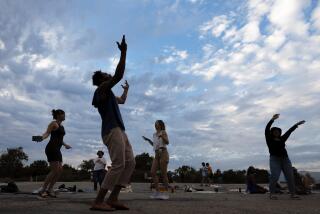Confidence is a wet T-shirt
- Share via
This month, millions of young people will congregate on sunny beaches as far from home as possible in order to relieve themselves from the stresses of academia. Their methods? Around-the-clock binge drinking and lively cultural activities such as near-naked girl-against-girl wrestling matches held in giant vats of pudding.
The Fort Lauderdale version of spring break was originally made famous by the 1960 film “Where the Boys Are,” but spring break is now thought to be best experienced in places like Cancun, Mexico, where the drinking age is 18 and tour companies build packages almost exclusively around access to alcohol: $100 procures a wristband that grants admission to clubs offering unlimited free alcohol.
Meanwhile, in news of the “no duh” variety, the American Medical Assn. released figures about sex and alcohol use during rowdy spring break vacations. The poll, which surveyed female college students and graduates aged 17 to 35, found that 74% believed women used drinking “as an excuse for outrageous behavior”; 83% “had friends who drank the majority of nights while on spring break”; and 12% “felt forced or pressured into sex” during spring break.
And no wonder. The Journal of American College Health has reported that women partying at spring break hot spots consume an average of 10 alcoholic drinks per day, and men consume an average of 18. Queasy yet? I know I am. A few years ago, I went to Cancun during spring break to research a magazine article. I was hoping to arrive at some grand psychological and existential reason as to why many of today’s college women (who, after all, were presumably pursuing higher education because they wanted to be more than sex objects) seem so happy to let men lick tequila shots off their body parts.
I didn’t exactly succeed. But after a week of talking to people in various states of undress and intoxication, I can tell you this much: What’s happening on spring break beaches isn’t just boys being boys and girls going wild. It’s young people, women especially, deciding that the way to measure their readiness for the adult world is not in terms of education or emotional maturity but sexual desirability.
The raunchy contests and general debauchery were something that these women had prepared for, almost as though for a final exam. They’d logged hours at the gym, in tanning booths and at body wax salons. They’d save up money for breast implants and then timed the surgery so they’d be healed by spring break. Some seemed to have practiced drinking, experimenting with different alcohol combinations to see what afforded the fastest buzz with the least amount of calories and dollars spent.
One word I heard again and again, oddly, was “confidence.” As they psyched themselves up for wet T-shirt contests or debated whether a given guy was worth flirting with, a lot of women told me that they saw spring break as the proving ground for their attractiveness. “If I can be considered hot here, I’ll be hot anywhere,” a rather morose woman sitting on a bar stool in a bikini and high heels told me. “I’m here to get confident.”
That’s sad, but it’s not exactly irrational given the context (no one was there, after all, to participate in a chess tournament). But the more women I talked to, the more it became clear that hotness was, for them, the largest factor in the equation of their self-worth. When they talked about what they wanted to do with their lives, they spoke not of jobs or grad school but of looking good, of having the right equipment and experience to ensure a place in the raunch-obsessed pop culture they’d come to see as the real world.
And why not? These days, miniskirts the size of cocktail napkins are considered appropriate mall attire for 14-year-olds. Local newscasters seem to regard see-through shirts as proper on-air attire. And illiteracy appears to have spread to the point at which parents can put a T-shirt on a 2-year-old without noticing that the words “Future Hooters Girl” are printed across the front. With girl power like that, can we really blame these women for seeing their sexuality as their only currency?
Of course, despite the fact that an estimated 170,000 kids are expected to descend on Cancun this season, there are many more who have better things to do than pass out on the beer-stained floor of Congo Bongo. But every March, when the spring drinking statistics get trotted out like so many vodka shots lined up on a bar, I’m reminded of how much they reveal about everyday life. Revelers may tell themselves that whatever happens in Cancun stays in Cancun, but in some ways, the party never ends.
I’m feeling less confident already.
--



